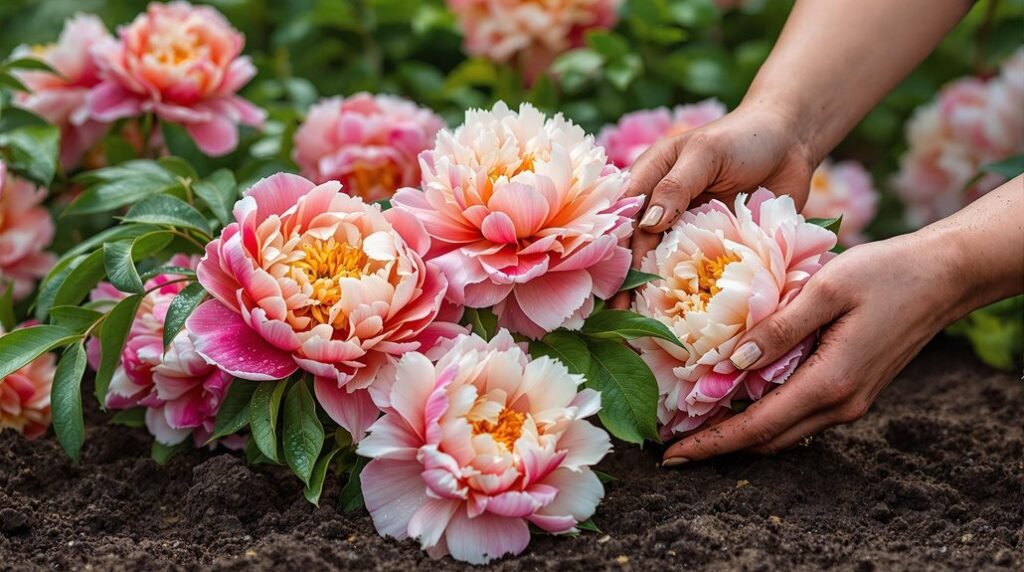Like a well-tended canvas, your garden can become a masterpiece with the right touch of peonies. These flowers symbolize beauty and resilience, but getting them to thrive takes more than just planting. You’ll want to know where and when to place them, how to nurture them through the seasons, and how to handle common challenges. Let’s explore what it takes to guarantee your peonies reward you with breathtaking blooms year after year.
Where to Plant Peonies
Choosing the right spot is crucial when planting peonies. You’ll want to pick a location that gets full sun—at least 6 to 8 hours daily—to guarantee ideal growth and vibrant blooms.
The soil should be deep, fertile, humus-rich, and well-draining to keep roots healthy and prevent rot. When planting, position the peonies’ eyes facing upward and bury them no more than 2 inches below the surface to promote proper bud formation.
Space your peony plants about 3 to 4 feet apart to allow ample air circulation, which helps reduce disease risk and supports strong development.
When to Plant Peonies
Although peonies can be planted in spring, you’ll get the best results by planting them in autumn, specifically in late September and October.
Planting your peonies during this time allows for ideal growth as the roots establish before the first winter after planting. If you’re in Zones 7 and 8, you can extend planting into late fall to accommodate warmer conditions.
Planting peonies in fall helps roots establish before winter, with extended timing in Zones 7 and 8.
When you plant peonies in the fall, make sure the eyes face upward and are positioned about 2 inches below the soil surface. Space them 3 to 4 feet apart to guarantee good air circulation, which helps prevent disease and promotes a full bloom.
Proper timing and spacing set your peonies up for a healthy, vibrant garden year after year.
How to Plant Peonies

To plant peonies successfully, start by selecting a sunny spot that gets at least 6 to 8 hours of direct sunlight daily and has well-draining, fertile soil.
Plant peonies in the fall, ideally between late September and October, to guarantee peak growth.
Before planting, amend the soil with compost to boost fertility and moisture retention.
Space peony plants about 3 to 4 feet apart to promote adequate air circulation, reducing disease risks.
When planting, position the eyes of the tubers facing upward and cover them with soil 2 inches below the surface.
After placing each plant, water deeply to remove air pockets around the roots.
Choosing a full sun location with well-draining soil and following these steps will set your peonies up for healthy, vibrant blooms.
Caring for Peonies Throughout the Seasons
Once your peonies are planted, maintaining their health throughout the year guarantees they continue to thrive and bloom beautifully.
Make sure your peony plants receive full sunlight—about 6-8 hours daily—for ideal growth. During the growing season, deadhead spent blooms promptly to encourage more flowers.
Ensure your peonies get 6-8 hours of sunlight daily and deadhead spent blooms to boost flowering.
Regularly check the soil well to keep it moist but not waterlogged. After blooming, apply fertilizer with a balanced, slow-release formula to support root development.
For young peonies, add a layer of mulch in fall to protect them from harsh winter conditions, but established plants need less.
In late fall, once frost arrives, cut back foliage to ground level to prevent disease. This ongoing care helps your plants stay vigorous and ready for the next season’s burst of stunning blooms.
Fall Maintenance and Dividing Peonies

When the foliage dies back after the first frost, you should cut your peonies to ground level to prevent disease and encourage healthy growth. This crucial fall maintenance step helps prepare your plants for winter dormancy.
After cutting back, side-dress your peonies with a balanced, slow-release fertilizer to nourish roots before winter. If winter is severe, apply mulch loosely around the base to provide winter protection and retain soil moisture. Additionally, consider using a fertilizer with beneficial microbes to enhance nutrient absorption and promote healthy root development.
Fall is also the ideal time for dividing peonies—about six weeks before the ground freezes. When dividing, make sure each section has 3 to 5 eyes to guarantee successful planting and growth.
Proper fall care sets the stage for vigorous, healthy growth come spring.
Harvesting and Preserving Peony Blooms
Although peonies look stunning in the garden, you’ll want to harvest their blooms at just the right time to enjoy their beauty indoors. The best moment is the “marshmallow stage,” when buds feel soft but aren’t fully open.
When harvesting your peonies as cut flowers, follow these steps to maintain freshness:
- Use clean, sharp pruners to cut stems at a steep angle above healthy leaves, leaving 1-2 inches of stem.
- Immediately re-cut the stem ends under running water to improve water uptake.
- Wrap stems in a damp paper towel, place them in a plastic bag, and store in the refrigerator until use.
- Change vase water regularly and add floral preservative to extend bloom life.
These simple steps help preserve your peonies’ vibrant beauty indoors.
Managing Pests and Diseases on Peonies
Even though peonies are generally hardy and deer-resistant, you’ll still need to watch for pests like Japanese beetles and aphids, as well as diseases such as Botrytis blight and Verticillium wilt.
Regular monitoring helps you catch issues early. Inspect your peonies frequently and treat pests with organic insecticides or insecticidal soaps, encouraging beneficial insects to keep harmful ones in check.
Frequent inspection and organic treatments help control pests while supporting beneficial insects for healthy peonies.
Prevent diseases by ensuring good air circulation—space plants 3 to 4 feet apart and remove debris around the base.
Practice proper watering and cultural care to reduce plant stress and boost resilience. If you spot wilting or discoloration, promptly remove affected parts and apply fungicides to stop disease spread.
Maintaining healthy plants through these steps keeps your peonies thriving and beautiful.
Frequently Asked Questions
What Is the Secret to Growing Peonies?
You’ll grow peonies best by planting in fall, giving them 6-8 hours of sun, using well-draining soil, placing roots just 2 inches deep with eyes up, and patiently caring for them over 2-3 years.
What Is the Best Month to Plant Peonies?
Think of planting peonies like setting the stage for a grand performance. You’ll want to plant them in late September or October to give roots time to settle before winter, ensuring a stunning bloom come spring.
Where Is the Best Place to Plant a Peonies Bush?
You should plant your peony bush in a sunny spot with at least 6 to 8 hours of sunlight daily. Choose well-draining, fertile soil, space plants 3 to 4 feet apart, and avoid windy or crowded areas.
How Do You Keep Peonies Blooming All Summer?
To keep your peonies blooming all summer, plant varieties with staggered bloom times, deadhead spent flowers promptly, give them 6-8 hours of sunlight, water regularly during dry spells, and fertilize sparingly after blooming.
Final Thoughts
By planting your peonies in the right spot and caring for them through each season, you’ll enjoy breathtaking blooms year after year. Remember to give them plenty of sunlight, well-draining soil, and space to breathe—just like a knight tending to his garden in days of yore. Keep up with pruning, pest control, and fall maintenance, and your peonies will reward you with stunning flowers that make your garden truly timeless.
